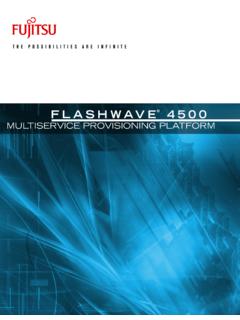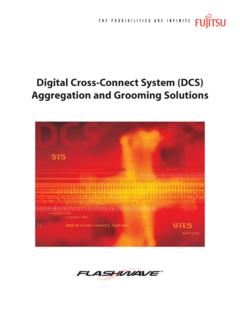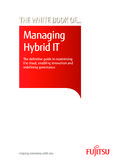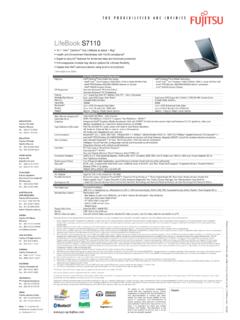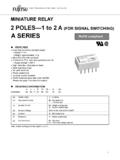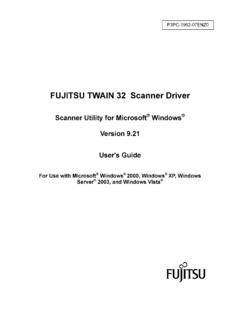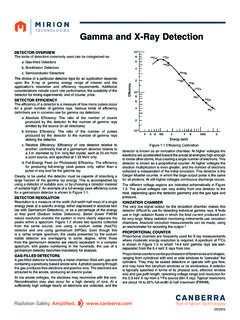Transcription of MSPP, MSTP and MSSP Network Elements - Fujitsu
1 MSPP, mstp and mssp Network ElementsWhat s the Difference and Do We Need All of this Terminology?1 Fujitsu Network COMMUNICATIONS Telecom Parkway, Richardson, Texas 75082-3515 Telephone: (972) 690-6000(800) 777-FAST ( ) have successfully deployed legacy SONET NEs in North America for the past 15 years. The marketsegmentation for these SONET ADM devices was fairly simple and easy to understand: devices were ADMswith the ability to drop a mix of legacy electrical and optical TDM circuits, mainly DSx and OC-n differentiation among the various platforms from an individual vendor was based on the OC-n rate ofthe high-speed interface with a specific set of service emergence of the next-generation SONET market has blurred the situation. We were first faced withthe term MSPP. Most individuals interpreted this market segment as a mere acronym for a next-generationSONET , in the spirit of crafting a new market niche, we have seen the emergence of additional marketsegments: mstp and intent of this paper is to first acknowledge these terms by describing them and positioning themagainst each other.
2 Next, we will revisit the terms unique characteristic to offer some simplification in thisovercrowded market the Market SegmentsThe MSPP is the oldest of the next-generation SONET NE market segment and supports the following: DS1 to OC-192 support No fixed high-speed interface; users can deploy this device at any OC-n rate Unrestricted STS-1 and switch fabrics for grooming and small DCS applications SONET mapping for a wide range of data interfaces such as Ethernet, Fibre Channel and DVB-ASI video GFP mapping of data servicesThe term MSPP has received broad support and was widely adopted by the carriers, the analyst communityand equipment vendors. The term is now generally associated with the next-generation SONET marketsegment, although the actual word SONET is not part of the acronym mstp is really a new twist on the MSPP. mstp is basically an MSPP plus integrated DWDM DWDM additions include transponders, optical amplifiers, passive DWDM couplers and OADM devices to drop selected wavelengths at a your convenience, a list of acronyms can be found at the end of this document.
3 2 Fujitsu Network COMMUNICATIONS Telecom Parkway, Richardson, Texas 75082-3515 Telephone: (972) 690-6000(800) 777-FAST ( ) category raises the following fundamental question: Should DWDM services be incorporated into theMSTP in the first place? This paper will address this question after defining the last market mssp acronym is used to represent platforms offering similar services as the MSPP but on a largerscale. The MSPP switch fabric is typically in the sub-100 Gbps capacity while the mssp resides in the300 Gbps range as a minimum. The question then becomes: do we need this category in the first place?To use an analogy with the legacy SONET market, we did not create a new market segment with theemergence of the OC-192 NEs or the larger ADM segment. Therefore, why create a new segment torepresent the largest devices? Actual value might exist in having separate market segments, which will bediscussed later in this MSPP + DWDM = mstp Makes Sense?
4 Carriers have always expressed concern about the same traditional issues: cost, space and power integrating DWDM directly into the mstp might initially seem like a good decision based on thesethree traditional requirements, the reality is often quite the issue involves the slot count of the MSPP. Most MSPPs have an average of 12 slots available for interfaceunits. In most cases, a typical MSPP deployed in a typical location will quickly run out of available that point, carriers need to obtain denser interface units from suppliers to reduce the consumption rateof the available slot integrating the DWDM functionality into the MSPP is not practical. This integration will onlyincrease the slot consumption within the example, suppose a carrier deploys a typical MSPP with 12 interface card slots and requires the node tointerconnect as an OC-192 device for an interoffice application. The pair of OC-192 units consumes two ofthe 12 interface slots within the device.
5 Let s suppose that the device requires two types of protectedinterfaces, OC-48 and DS3, dropping from the OC-192 ring. This process will require another four interfacecard slots. At that point, the carrier is left with six available interface card ,if they require DWDM at the site, a DCM unit along with an amplifier and a passive coupler for a singleside of the OC-192 ring is needed. Thus, the integration of the DWDM functionality directly on the devicewill require another three slots. Although this process is technically possible, it leaves the device with onlythree available slots and very little room for future Network COMMUNICATIONS Telecom Parkway, Richardson, Texas 75082-3515 Telephone: (972) 690-6000(800) 777-FAST ( ) 1: Typical mstp Deployment Requirement ExampleAnother issue is the STS-1 and switch fabric consumption. MSPP and mstp devices are centered onlarge switch fabrics typically dropping 10G of capacity to every interface card.
6 Any DWDM integration intothe mstp will forgo the use of this switch fabric in the slots where the DWDM units are other words, in the example described above, the user would forgo the use of 30G of useful groomingcapacity in the three slots where the amplifier, DCM and passive coupler are located. Considering that thelargest cost of an mstp is the switch fabric, this loss of switch fabric capacity is clearly a waste of thecarrier s three arguments show that the direct integration of DWDM within the mstp can lead to negativeconsequences in terms of cost, space and power: Rapid consumption of mstp slots will push the premature deployment of a second collocated collocation of this second mstp contributes to eliminate any possible space advantages throughthe inclusion of DWDM functionality into the mstp . The collocation of a second mstp will increase power usage. In a way, power is always tracking spaceconsumption in a central office.
7 The cost benefits of the mstp are also negated by the underutilization of the STS-1 and switchfabric for the slots where the DWDM units are located. Again, the single largest cost of the mstp is theswitch fabric and deploying DWDM units in the interface slots lead to an underutilization of thisprecious or DWDMS lots RequiredSlots RemainingOC-192 MSPP210DS3 MSPP28OC-48 MSPP26 Passive CouplerDWDM15 AmplifierDWDM14 DCM ModuleDWDM134 Fujitsu Network COMMUNICATIONS Telecom Parkway, Richardson, Texas 75082-3515 Telephone: (972) 690-6000(800) 777-FAST ( ) Better Alternative to the MSTPA better approach is to leave the SONET transport functionality and the STS-1 and switch fabricusage to the MSPP and deploy DWDM functionality in a separate collocated shelf as an adjunct to theMSPP. However, in order to be effective, the DWDM functionality must focus on the following specificapplications and criteria: Target the application space as a fiber relief, amplification and DCM compensation shelf providingspecialized DWDM services to the MSPP.
8 Utilize a small shelf to ensure that the collocation of an MSPP with this specialized DWDM system isphysically smaller than two collocated MSTPs. Optimize the price around the application space so the addition of the DWDM service shelf does notdrastically change the cost equation of the MSPP. Integrate the software of the two shelves so the MSPP and the complementary DWDM system can bemanaged as a single summary, leave the MSPP to perform SONET transmission without any loss of interface slots and providea cost effective small DWDM service shelf with a few slots to complement the MSPP where DWDM approach is superior and in the end, leads to better space, cost and power usage when compared to anarchitecture which attempts to perform everything in a single About the mssp ?The term mssp has emerged in recent years to denote large MSPP systems, which have switching andgrooming capacity of at least 300 Gbps.
9 One noticeable difference is that most MSSPs do not providegranularity down to the DS1 level, and many of them are actually pure optical systems in terms of availableinterface are clearly filling a different market segment when compared to the MSPP. MSSPs represent CO-based systems in large office locations, which are used to groom a large number of access rings andinterconnect directly to the various IXC networks interconnecting at that particular Network planner must really understand the differences between the MSPP and mssp when deciding ona deployment strategy. He must also choose which device should be deployed at every site within thenetwork. Typically, this decision comes down to answering the following question: When faced with a giveninitial capacity requirement, do I start with an MSPP or do I go directly to an mssp assuming a rapidcapacity growth in that office?This question might seem relatively simple but in reality it is not.
10 Most often, the initial deployment cost ofan mssp lies in about $100K of initial capital expense for the purchase of the system s managementcomplex. The mssp requires an extensive management complex, which is proportional to the size of thedevice, but this management complex comes at a Network COMMUNICATIONS Telecom Parkway, Richardson, Texas 75082-3515 Telephone: (972) 690-6000(800) 777-FAST ( ) all the different deployment and capacity growth scenarios, you find that the followingpossibilities can actually occur: Traffic demand is initially low, the carrier deploys an MSPP and the traffic demand remains low, leavingunused MSPP capacity. In this scenario, the Network planner made the right deployment decision. Traffic demand is initially low, the carrier deploys an MSPP and the traffic demand increases much fasterthan anticipated, creating a situation where either a second MSPP or an mssp is required.

